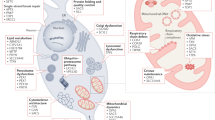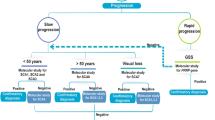Abstract
Introduction
Friedreich’s ataxia (FDRA) is the most common autosomal recessive, early-onset ataxia. FDRA is a progressive neurodegenerative disease that mainly affects the posterior (dorsal) columns of the spinal cord resulting in sensory ataxia. It manifests in initial symptoms of poor coordination and gait disturbance.
Case presentation
We present two cases, a brother (54 years old) and sister (56 years old), with FDRA that are chronically institutionalized for incomplete quadriplegia without spasticity. Gait and postural ataxia, cerebellar dysarthria, oculomotor dysfunction, musculoskeletal deformities, hearing impairment, hypertrophic cardiomyopathy, and diabetes mellitus are also present. Neurological examination reveals extensor plantar responses and diminished to absent tendon reflexes. Both are wheelchair bound, cannot perform daily tasks and need assistance.
Discussion
Although there is no cure that can alter the natural course of the disease physiotherapy, management of spasticity and neuropathic pain, symptomatic treatment of heart failure and diabetes and nursing care can grant the patients quality of life.
Similar content being viewed by others
Introduction
Friedreich’s ataxia (FRDA), which was first described in 1863, is a hereditary early-onset neurodegenerative disease affecting mainly the central and to a lesser extent the peripheral nervous system. FDRA is the most common autosomal recessive ataxia, with estimated prevalence of 1 in 50,000 people and with a carrier frequency of 1 in 120 people [1]. The pathogenic mutation in FDRA is a homozygous guanine-adenine-adenine (GAA) trinucleotide repeat expansion in the first intron of the human frataxin gene (FXN) [2, 3], located on chromosome 9p13–21, that causes a transcriptional defect of the frataxin gene and reduced expression of the small mitochondrial protein frataxin [4]. Although the exact cellular role of frataxin remains unclear it seems that it is involved with respiration, iron–sulfur cluster assembly, iron homeostasis, and maintenance of a redox status. Frataxin deficiency results in mitochondrial iron accumulation and renders neurons prone to oxidative stress and Wallerian degeneration. All manifestations of FDRA are a direct result of the degeneration and atrophy of the posterior columns, the spinocerebellar tracts, the corticospinal tracts, the dentate and inferior olivary nucleus, the dorsal spinal roots and dorsal root ganglia, and the sensory peripheral nerves [5]. The disease presents early in life (5–10 years old) with a mean duration of 26 years (±14 years). Death comes around the age of 40 (±20 years) [4] from complications of the hypertrophic cardiomyopathy such as heart failure (59%), arrhythmias, embolic stroke, and myocardial infraction [6]. The fundamental features of FRDA are progressive afferent ataxia, loss of balance, poor coordination, ataxic dysarthria (typically after 5 years from onset), dysphagia, pyramidal weakness, loss of proprioception and vibration sense, absent tendon reflexes especially in lower limbs (due to concomitant peripheral neuropathy), and extensor plantar responses. Nystagmus, optic atrophy, hearing impairment, scoliosis, and pes cavus may also be present. A high prevalence of hypertrophic cardiomyopathy and diabetes mellitus is also noted among the patients [7, 8].
Case presentation
We present two cases, a brother (54 years old) and sister (56 years old), with FRDA that are chronically institutionalized at “Hospice for Neuro-disability” for the past 15 years due to incomplete quadriplegia without spasticity. For the female patient, disease onset was at 14 years of age with gait ataxia and intention (cerebellar) tremor. Thorough neurological examination revealed diminished to absent deep tendon reflexes (hyporeflexia) especially on lower limbs, extensor plantar responses (Babinski sign) and a positive Romberg test suggesting sensory ataxia. Family history revealed that the patient’s father was diagnosed with Roussy–Levy Syndrome (hereditary areflexic dystasia), a variant of Charcot–Marie–Tooth disease. Before the availability of molecular diagnosis in 1996, FRDA was underdiagnosed in favor of Charcot–Marie–Tooth disease [9]. All laboratory and imaging testing were normal, as well as the electromyogram (EMG), the sensory and motor nerve conduction studies and the electroencephalogram. Over the course of 10 years the ataxia spread to the arms and then the trunk and signs of cerebellar dysfunction (such as cerebellar dysarthria with slow slurred speech, nystagmus, dysmetria, and dysdiadochokinesia) become apparent, as well as the loss of vibration sense and proprioception (due to the degeneration of the posterior columns) and the diffuse muscle weakness (due to degeneration of the corticospinal tract). After excluding other conditions such as early-onset cerebellar ataxia [10], the diagnosis was based on clinical data and was later confirmed through genetic testing. For the male patient, the disease onset was at the age of 15 and the first manifestation was kyphoscoliosis. The course of the disease was the same to that of his sister. However, the musculoskeletal deformities were more prevalent with severe postural ataxia and pes cavus. Both patients suffer from hypertrophic cardiomyopathy, diabetes mellitus, and hypertension. The electrocardiogram (ECG) of the female patient (Fig. 1) shows the hypertrophic cardiomyopathy with the increased R wave amplitude, the left axis deviation and the characteristic T-wave inversion in the left precordial leads (V4–V6) indicating anterolateral myocardial fibrosis which is typical for the disease. Complete vision loss due to optic nerve atrophy, hearing impairment and depression are also present. They are wheelchair bound, cannot perform daily tasks and need assistance due to incomplete quadriplegia. Cognitive functions are not affected by the disease.
Discussion
Clinical management and intervention
There are many therapeutic approaches; however, none can alter the course of the disease. We focus on the symptomatic treatment of complications to help our patients maintain the maximum possible function and quality of life. Our therapeutic choices were in accordance with the consensus guidelines that were compiled in 2014 under the auspices of Friedreich’s Ataxia Research Alliance (F.A.R.A) [11, 12]. For the management of the neurological components of FDRA our patients are examined regularly and receive occupational and physical therapy to preserve muscle strength and improve flexibility and accuracy of limb movements. Passive range of motion (ROM) exercises and stretches are used to reduce the stiffness of joints and prevent contractures that can cause pain. Back pain which is common due to the abnormal posture and myopathic pain in general can be prevented by proper wheelchair placement and are treated with non steroids anti-inflammatory drugs (NSAIDs) and muscle relaxants, whereas neuropathic pain and rhizopathy require Gabapentin, Pregabalin, Lamotrigine, Amitriptyline or Duloxetine. Although spasticity is not a typical symptom of FDRA, frequent assessment for spasticity and spasms is necessary. Acute onset or exacerbation of spasticity and/or aggravation of ataxia can be signs of neuropathic pain, infection, constipation, dehydration, or other medical problems, indicating clinical deterioration. Anti-spasticity intervention is required to prevent permanent contractures. After detecting the affected muscles with EMG, oral medications (such as Baclofen, Tizanidine, Dantrolene, Gabapentin), and the intrathecal Baclofen pump are the best option for generalized spasticity, whereas intramuscular botulinum toxin or phenol can help with more focal problems [13, 14]. Orthopedic devices and bracing are used for kyphoscoliosis and the other musculoskeletal disorders. Current recommendations insist that treatment for diabetes should be initiated early and insulin is preferred over oral antidiabetics. Our patients receive a combination of Metformin, Pioglitazone, and Glimepiride without achieving good glycemic control and thus we are considering conversion to insulin despite the fear of hypoglycemia. For the hypertension and the hypertrophic cardiomyopathy which can lead to heart failure Metoprolol, a selective β1 receptor blocker, is used. At the ECG which is performed at least annually no arrhythmias are present. Depression is treated with Citalopram, a selective serotonin reuptake inhibitor. Both have indwelling urinary catheters due to neurologic bladder dysfunction (overactive detrusor muscle), and their inability to perform intermittent self-catheterization. They also receive multivitamin supplements that contain vitamin B (B1, B6, and B12) and antioxidants (vitamin E and coenzyme Q) and adequate nutrition. They are provided with nursing care, and frequent repositioning and mobilization in order to prevent pressure ulcers.
Although there is no cure that can alter the natural course of the disease physiotherapy, management of spasticity and neuropathic pain, symptomatic treatment of heart failure and diabetes and nursing care can grant the patients quality of life.
References
Cossée M, Schmitt M, Campuzano V, Reutenauer L, Moutou C, Mandel JL, et al. Evolution of the Friedreich’s ataxia trinucleotide repeat expansion: founder effect and premutations. Proc Natl Acad Sci USA. 1997;94:7452–7.
Santos R, Lefevre S, Sliwa D, Seguin A, Camadro JM, Lesuisse E. Friedreich ataxia: molecular mechanisms, redox considerations, and therapeutic opportunities. Antioxid Redox Signal. 2010;13:651–90.
Pandolfo M. Friedreich’s ataxia: clinical aspects and pathogenesis. Semin Neurol. 1999;19:311–21.
Koeppen AH. Friedreich’s ataxia: pathology, pathogenesis, and molecular genetics. J Neurol Sci. 2011;303:1–12.
Koeppen AH, Mazurkiewicz JE. Friedreich ataxia: neuropathology revised. J Neuropathol Exp Neurol. 2013;72:78–90.
Tsou A, Paulsen E, Lagedrost S, Perlman S, Mathews K, Wilmot G, et al. Mortality in Friedreich Ataxia. J Neurol Sci. 2011;307:46–49.
Stephenson J, Zesiewicz T, Gooch C, Wecker L, Sullivan K, Jahan I, et al. Gait and balance in adults with Friedreich’s ataxia. Gait Posture. 2015;41:603–7.
Parkinson MH, Boesch S, Nachbauer W, Mariotti C, Giunti P. Clinical features of Friedreich’s ataxia: classical and atypical phenotypes. J Neurochem. 2013;126:103–17.
Delatycki MB, Williamson R, Forrest SM. Friedreich ataxia: an overview. J Med Genet. 2000;37:1–8.
Claus D. Differential diagnosis of Friedreich ataxia. Nervenarzt. 1989;60:26–31.
Corben LA, Lynch D, Pandolfo M, Schulz JB, Delatycki MB, Clinical Management Guidelines Writing Group. Consensus clinical management guidelines for Friedreich ataxia. Orphanet J Rare Dis. 2014;9:184.
Bidichandani SI, Delatycki MB. Friedreich Ataxia. In: Adam MP, Ardinger HH, Pagon RA, Wallace SE, Bean LJH, Stephens K, Amemiya A, (eds). GeneReviews® [Internet]. Seattle, WA: University of Washington; 1998.
Thompson AJ, Jarrett L, Lockley L, Marsden J, Stevenson VL. Clinical management of spasticity. J Neurol Neurosurg Psychiatry. 2005;76:459–63.
Pattuwage L, Olver J, Martin C, Lai F, Piccenna L, Gruen R, Bragge P. Management of spasticity in moderate and severe traumatic brain injury: evaluation of clinical practice guidelines. J Head Trauma Rehabil. 2017;32:E1–12.
Acknowledgements
We thank various people for their contribution to this project. We also thank Dr. Xanthopoulou Elpida and all the nursing staff of Hospice for disability their help in collecting data (ASYLON ANIATON).
Funding:
No financial support has been received for this work
Author information
Authors and Affiliations
Corresponding author
Ethics declarations
Conflict of interest
The authors declare that they have no conflict of interest.
Rights and permissions
About this article
Cite this article
Dionyssiotis, Y., Kapsokoulou, A., Danopoulou, A. et al. Clinical management of Friedreich’s Ataxia: a report of two cases. Spinal Cord Ser Cases 4, 38 (2018). https://doi.org/10.1038/s41394-018-0071-x
Received:
Revised:
Accepted:
Published:
DOI: https://doi.org/10.1038/s41394-018-0071-x




